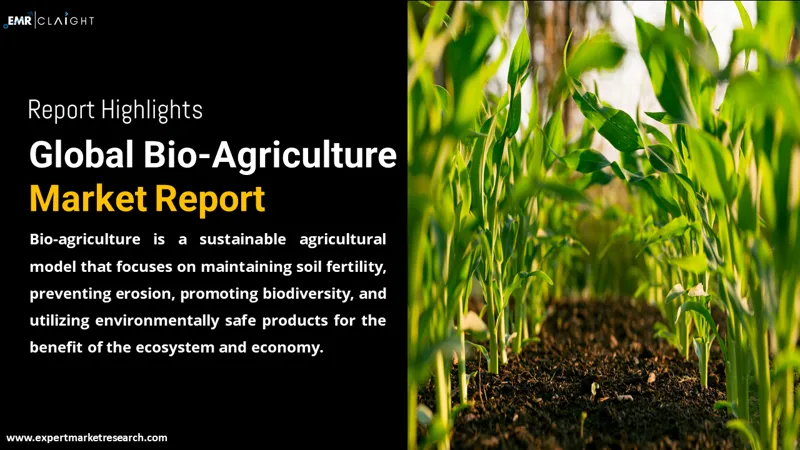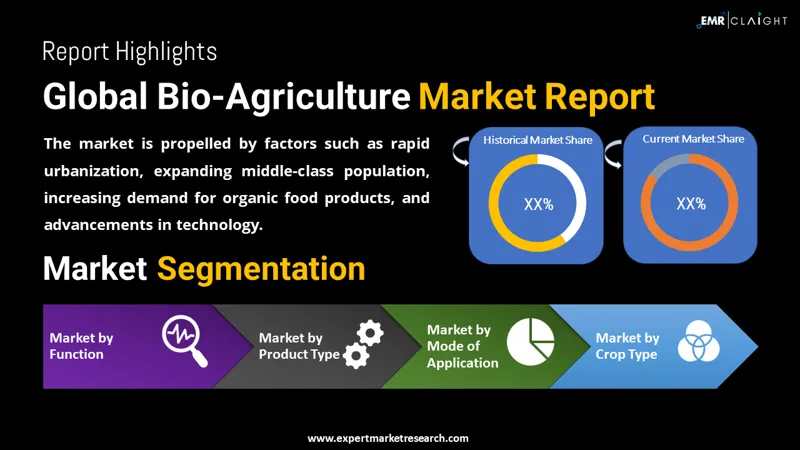
Consumer Insights
Uncover trends and behaviors shaping consumer choices today
Procurement Insights
Optimize your sourcing strategy with key market data
Industry Stats
Stay ahead with the latest trends and market analysis.
The global bio-agriculture market value of USD 14.97 Billion in 2025. The market is further expected to grow in the forecast period of 2026-2035 at a CAGR of 12.10% to reach a value of USD 46.91 Billion by 2035.
Base Year
Historical Period
Forecast Period
Compound Annual Growth Rate
12.1%
Value in USD Billion
2026-2035
*this image is indicative*
| Global Bio-Agriculture Market Report Summary | Description | Value |
| Base Year | USD Billion | 2025 |
| Historical Period | USD Billion | 2019-2025 |
| Forecast Period | USD Billion | 2026-2035 |
| Market Size 2025 | USD Billion | 14.97 |
| Market Size 2035 | USD Billion | 46.91 |
| CAGR 2019-2025 | Percentage | XX% |
| CAGR 2026-2035 | Percentage | 12.10% |
| CAGR 2026-2035 - Market by Region | Asia Pacific | 15.1% |
| CAGR 2026-2035 - Market by Country | India | 15.9% |
| CAGR 2026-2035 - Market by Country | Canada | 14.3% |
| CAGR 2026-2035 - Market by Function | Crop Enhancement | 15.1% |
| CAGR 2026-2035 - Market by Product Type | Microbials | 13.3% |
Bio-Agriculture is an economically and ecologically sustainable model of agriculture that maintains and enhances soil fertility, prevents soil erosion, and promotes and increases biodiversity and the usage of safe products for the benefit of the environment. It protects the long-term fertility of the soil and recycles animal wastes back to the farm. Bio-agriculture avoids the use of synthetic chemicals, which drives the demand for the bio-agriculture market.

Read more about this report - REQUEST FREE SAMPLE COPY IN PDF
The global market for bio-agriculture is a rapidly emerging industry that is adopting various technological reforms to boost and sustain the system, thus, ensuring the continued bio-agriculture industry growth.
The industry is expected to grow robustly due to the growing use of biofertilisers and the rising awareness of the adverse health and environmental impacts of synthetic fertilisers. Bio-agriculture focuses on crop protection and enhancement without compromising the quality of the product, which further enables the growth of the bio-agriculture market.
According to The Research Institute of Organic Agriculture Survey 2024, In 2022, the total global organic agricultural land increased to approximately 96.4 million hectares, reflecting a significant growth of 20.3 million hectares from 2021. Oceania led with 53.2 million hectares dedicated to organic farming. Europe followed with 18.5 million hectares, while Asia contributed 8.8 million hectares. Northern America covered 3.6 million hectares, indicating the extensive adoption of organic agriculture in these areas, and further boosting the bio-agriculture industry revenue.
In 2022, the global organic agriculture sector included 4.5 million producers, with Asia holding the largest share at 2.73 million, accounting for over 60% of the world's organic producers. This high concentration in Asia is mainly due to India, which alone has about 2.6 million organic farmers, making it the top country for organic producers. The number of global organic producers grew by 25.6% from 2021 to 2022, adding more than 900,000 new producers in just one year. Over 90% of these producers are based in Asia, Africa, and Europe. This significant growth in the bio-agriculture market reflects the increasing global shift towards sustainable agricultural practices, as per The Research Institute of Organic Agriculture survey 2024.
According to the Directorate of Plant Protection, Quarantine & Storage, India's bio-pesticide consumption in 2022-23 has increased to 7,248 metric tons, up from 7,203 metric tons in 2018-19. Andhra Pradesh significantly increased its usage from 10 MT to 51 MT, demonstrating a strong rise in adoption. Chhattisgarh experienced significant growth, with consumption increasing from 505 MT to 740 MT, demonstrating strong regional demand and further enhancing the bio-agriculture market revenue.

Read more about this report - REQUEST FREE SAMPLE COPY IN PDF
“Global Bio-Agriculture Market Report and Forecast 2026-2035” offers a detailed analysis of the market based on the following segments:
Market Breakup by Function
Market Breakup by Product Type
Market Breakup by Mode of Application
Market Breakup by Crop Type
Market Breakup by Region
| CAGR 2026-2035 - Market by | Country |
| India | 15.9% |
| Canada | 14.3% |
| China | 13.3% |
| USA | 12.3% |
| Australia | 10.3% |
| Japan | 9.0% |
| UK | XX% |
| Germany | XX% |
| France | XX% |
| Italy | XX% |
| Saudi Arabia | XX% |
| Brazil | XX% |
| Mexico | XX% |
The growth of the bio-agriculture market can also be attributed to the increasing demand for organic products, climate change, improvement of productivity and yield, and the growth of the global population. The increasing concerns about food contaminations and genetically modified food and the risks associated with them have provided further impetus to the growth of organic farming.
The bio-agriculture market dynamics and trends are being driven by rapid urbanisation and the expanding middle-class population, which are key factors contributing to the market's growth.
Favourable government schemes, such as the National Mission for Sustainable Agriculture (NMSA) and Rashtriya Krishi Vikas Yojana (RKVY), which were launched by the Indian government, are also expected to propel the bio-agriculture demand growth.
The companies specialise in creating eco-friendly solutions for agricultural growers worldwide, focusing on bio-based pest management and plant health products that improve crop yields and sustainability.




*While we strive to always give you current and accurate information, the numbers depicted on the website are indicative and may differ from the actual numbers in the main report. At Expert Market Research, we aim to bring you the latest insights and trends in the market. Using our analyses and forecasts, stakeholders can understand the market dynamics, navigate challenges, and capitalize on opportunities to make data-driven strategic decisions.*
Get in touch with us for a customized solution tailored to your unique requirements and save upto 35%!
In 2025, the global Bio-Agriculture market attained a value of nearly USD 14.97 Billion.
The global Bio-Agriculture market is assessed to grow at a CAGR of 12.10% between 2026 and 2035.
The market is estimated to witness healthy growth in the forecast period of 2026-2035 to reach USD 46.91 Billion by 2035.
The market is being driven by rapid industrialisation, the emergence of the rising middle class population, technological advancements, and the surging demand for organic food products.
The key trends guiding the market include environmental consciousness, the rising adoption of biofertilisers, and the introduction of favourable government initiatives promoting sustainable agricultural practices.
The market is broken down into North America, Europe, Asia Pacific, Latin America, the Middle East, and Africa.
The leading function segments in the market are crop protection and crop enhancement.
The major product types in the market are microbials, macrobials, semiochemicals, and natural products.
The significant modes of application of bio-agriculture in the market are foliar spray, seed treatment, and soil treatment.
The leading crop types in the market are cereals and grains, oilseeds and pulses, and fruits and vegetables, among others.
The competitive landscape consists of Marrone Bio Innovations, Certis USA L.L.C, National Fertilizers Ltd., Novozymes A/S, and Mapleton Agri Biotec Pt Ltd, among others.
Explore our key highlights of the report and gain a concise overview of key findings, trends, and actionable insights that will empower your strategic decisions.
| REPORT FEATURES | DETAILS |
| Base Year | 2025 |
| Historical Period | 2019-2025 |
| Forecast Period | 2026-2035 |
| Scope of the Report |
Historical and Forecast Trends, Industry Drivers and Constraints, Historical and Forecast Market Analysis by Segment:
|
| Breakup by Function |
|
| Breakup by Product Type |
|
| Breakup by Mode of Application |
|
| Breakup by Crop Type |
|
| Breakup by Region |
|
| Market Dynamics |
|
| Competitive Landscape |
|
| Companies Covered |
|
| Report Price and Purchase Option | Explore our purchase options that are best suited to your resources and industry needs. |
| Delivery Format | Delivered as an attached PDF and Excel through email, with an option of receiving an editable PPT, according to the purchase option. |
Single User License
One User
USD 3,999
USD 3,599
tax inclusive*
Datasheet
One User
USD 2,499
USD 2,249
tax inclusive*
Five User License
Five User
USD 4,999
USD 4,249
tax inclusive*
Corporate License
Unlimited Users
USD 5,999
USD 5,099
tax inclusive*
*Please note that the prices mentioned below are starting prices for each bundle type. Kindly contact our team for further details.*
Flash Bundle
Small Business Bundle
Growth Bundle
Enterprise Bundle
*Please note that the prices mentioned below are starting prices for each bundle type. Kindly contact our team for further details.*
Flash Bundle
Number of Reports: 3
20%
tax inclusive*
Small Business Bundle
Number of Reports: 5
25%
tax inclusive*
Growth Bundle
Number of Reports: 8
30%
tax inclusive*
Enterprise Bundle
Number of Reports: 10
35%
tax inclusive*
How To Order

Select License Type
Choose the right license for your needs and access rights.

Click on ‘Buy Now’
Add the report to your cart with one click and proceed to register.

Select Mode of Payment
Choose a payment option for a secure checkout. You will be redirected accordingly.
Gain insights to stay ahead and seize opportunities.

Get insights & trends for a competitive edge.

Track prices with detailed trend reports.

Analyse trade data for supply chain insights.

Leverage cost reports for smart savings

Enhance supply chain with partnerships.

Connect For More Information
Our expert team of analysts will offer full support and resolve any queries regarding the report, before and after the purchase.
Our expert team of analysts will offer full support and resolve any queries regarding the report, before and after the purchase.
We employ meticulous research methods, blending advanced analytics and expert insights to deliver accurate, actionable industry intelligence, staying ahead of competitors.
Our skilled analysts offer unparalleled competitive advantage with detailed insights on current and emerging markets, ensuring your strategic edge.
We offer an in-depth yet simplified presentation of industry insights and analysis to meet your specific requirements effectively.
Share